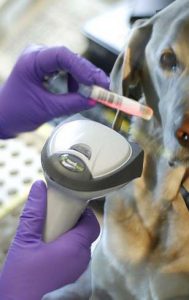
Why Might My Dog Or Cat’s aPTT Blood Clotting Time Be Delayed Or Shortened?
Your Pet’s Activated Partial Thromboplastin Time aka aPTT, partial thromboplastin time (PTT)
Ron Hines DVM PhD
When your veterinarian is suspicious that your dog or cat might have a blood-clotting problem that is leading to internal or external bleeding, or perhaps unexplained anemia; one of the most sensitive tests for detecting a blood-clotting defects is the aPTT test.
Because the clotting of your dog or cat’s blood is such a complex process (the coagulation cascade) with many different stages or steps and the interplay of so many compounds and cells; a series of tests on your cat or dog’s blood sample might be required to determine exactly what went wrong. The other common tests are a thrombocyte count, the pet’s prothrombin time (PT), partial thromboplastin time (PTT), fibrinogen level, the d-dimer test and thrombin clot time (TCT). Sometimes more than one, but never all, are required.
Problems That Might Cause Abnormally Long aPTT Times In Your Dog Or Cat:
Shock-induced coagulation (=DIC). In DIC, the clotting cascade is suddenly activated throughout the body using up the various essential blood clotting factors.
Liver failure. Fourteen essential blood clotting factors are produced by your pet’s liver. When its liver has lost its ability to produce them, the dog or cat’s blood clotting mechanism will fail. (read here)
Certain rodent poisons. Rodent baits that contain warfarin-like ingredients work by disabling the blood clotting process of rats and mice. When the baits or sick rodents are consumed in sufficient quantity by pets, they do the same thing to the dog or cat.
Hemophilia, a genetic defect in dogs and humans that limits the liver’s ability to produce Factor VIII can be the underlying cause. (read here)
In dogs, babesiosis or ehrlichiosis, leptospirosis or bacterial septicemias have been known to slow the blood clotting process. Extended aPTT times have also been documented in some Bernese Mountain Dogs due to genetic problems still to be defined.
In cats FeLV, FIP, FIV and panleukopenia can also have effects on aPTT time.
Problems That Can Shorten aPTT Times In Your Dog And Cat:
Inflammation or trauma anywhere in your dog or cat’s body has been known to shorten aPTT time – the length of time it takes blood to clot. When that occurs locally, it is called thrombosis. If and when that occurs is unpredictable and the opposite effect has also been noted.
DxMe
You are on the Vetspace animal health website
Visiting the products that you see displayed on this website help pay the cost of keeping these articles on the Internet.